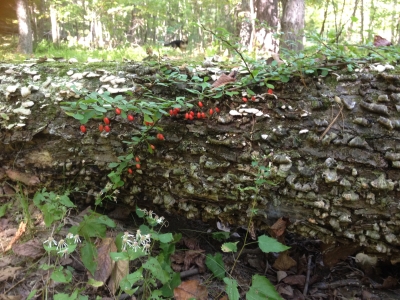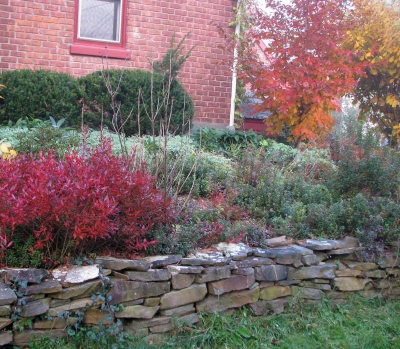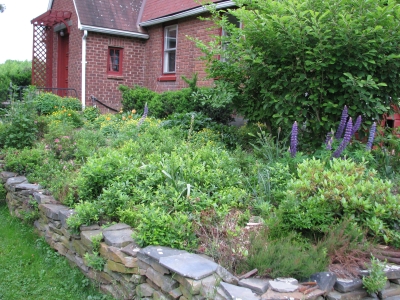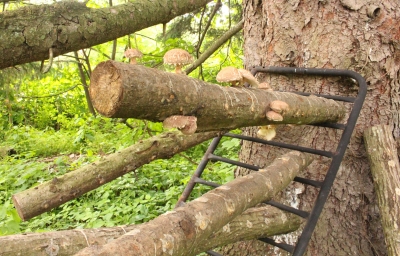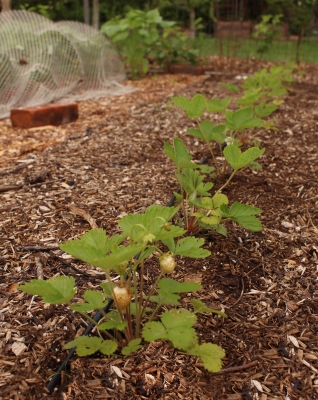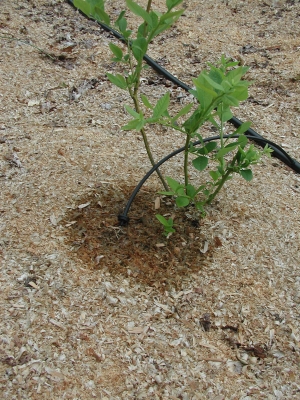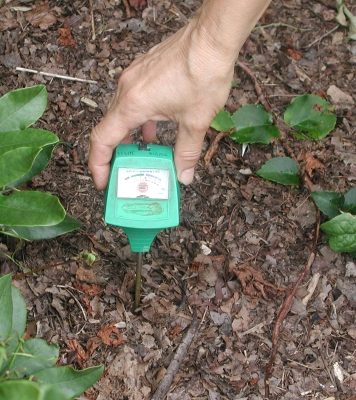HEATHERS & BARBERRIES & TICKS, OH NO!
/7 Comments/in Fruit, Gardening, Pests, Soil/by Lee ReichAn Evil Beauty
Uh oh! I was pulling an odd weed here and there in my heath bed and came upon a seedling of Japanese barberry (Berberis thunburgii). Should I start checking myself for deer ticks? Are all the plants in the bed soon to expire?
Japanese barberry is a commonly planted ornamental that was introduced into this country almost 150 years ago. For decades upon decades, it sedately graced landscapes with its boxwood-like leaves (but not evergreen), yellow flowers, and bright red berries, all set off against a backdrop of dark brown, thorny stems.
For some reason, the plant began to spread about 35 years ago. Perhaps it was the increased planting of barberries around homes, along highways, and outside shopping malls. Those plants spawned yet more plants as birds ate the berries and spread the seeds. Perhaps it was the surge in deer populations, a response to the creep of suburbia as well as to the decreased number of humans willing to take to the woods, rifle in hand, to fell a deer. All the while that deer were munching away on our roses, rhododendrons, yews, and other landscape plants, they rarely browsed barberry.
Okay, so more deer means more Lyme disease. Deer blood is what nourishes adult ticks and, as they feed, they reproduce and hitchhike across the landscape on their deer hosts.
But the Lyme bacteria actually get into the ticks only after feeding on the blood of small rodents, such as white-footed mice, that are harboring the bacteria. Recent research in Connecticut has shown that barberry also creates a very nice, sheltered habitat for mice.
To make matters worse, barberry also makes things homey for the deer ticks themselves, mostly by providing humidity. A forest with barberry growing in it hosted 120 Lyme-carrying ticks per acre; without barberry, a mere 10 per acre.
Earthworms, Friends No More?
So much for the threat of Lyme disease in my heath bed. What about the demise of the plants there?
Turns out that barberry is also prime habitat for earthworms, which, at first blush, would seem like a good thing. After all, earthworms are a gardener’s friend, right? Maybe. North of where the last glacier descended, the southern extent of which cut into much of northern U.S., all native earthworms were wiped out. The natives have been very slow to re-colonize but earthworms from Europe and Asia that arrived here in ship hulls and soil, and as fishing bait, have not been shy. They’ve spread rapidly.
Non-native earthworms thrive especially well in the soil beneath barberry bushes. It could be that barberry leaves are more digestible to them; it could be that barberry alters the soil chemistry to their liking.
These exotic earthworms are good at gobbling up raw organic matter, as in the leaf litter that blankets our forests — and my heath bed, to which I import leaves. The newcomers can actually gobble up forest litter faster than it is replenished, changing the soil habitat and exposing the soil to erosion. Plants in the heath bed, i.e. plants in the heath family, like that leaf litter; it keeps the soil cool and moist and, as it slowly decomposes, enriches the soil beneath with decomposed organic matter, or humus. There is some evidence that the makeup of our native forests, which includes rhododendrons, also in the heath family, is changing due to the work of exotic earthworms.
And all this from barberry!
Some Redemption
I’m not all that worried about ticks or the demise of my heath bed. The bed is small enough and watched closely enough so that all barberries can be ripped out — just like the one I saw yesterday. My cat keeps mice at bay, and my dogs do likewise for deer. And I import more leaves each year than earthworms, even exotic ones could gobble up.
The extensiveness of wild settings makes barberry control there difficult. Options there are cutting, pulling, fire, and/or herbicides.
No need for such drama In a home landscape. Here, barberry is easily controlled, if desired, by nothing more than being pulled out or repeatedly cut to the ground. One or a few bushes are not going to significantly impact mouse populations or Lyme hazard. Their greatest impact would be to make berries that, with the help of birds, would further the spread of this bush. Newer, sterile varieties offer ornamental mounds of greenery that don’t contribute to the plant’s spread.
Heather, and Friends
My heath bed, incidentally, has no heath plants. Heaths (Erica spp.) would die from in our cold winters. I call my bed a “heath bed” because in it I grow Heath Family (Ericaceae) plants in it: rhododendrons, mountain laurels, lingonberries, huckleberries, swamp azalea, and some heather (Calluna spp.). I group these plants together because all demand special soil conditions, conditions quite different from that of most cultivated plants.
Most heath plants need a soil that is very, very acidic, relatively infertile, well-aerated, consistently moist, and rich in organic matter. As mentioned above, these plants thrive where the ground also has a mulch of leaf litter, wood chips, or other organic matter, a mulch that disappears too quickly where soils harbor large populations of the non-native earthworms that thrive beneath barberry bushes.
MAKING THE MOST OF WET GROUND
/6 Comments/in Fruit, Gardening, Soil/by Lee ReichHave Fun, You Silly Ducks
Wouldn’t you know it: I write about the extended dry spell one week, and the next week, which is now, the rain comes and doesn’t let up. Not that all this rain makes me regret having a drip irrigation system watering my garden. Rainfall could come screeching to a halt and send us into another dry spell.
My five Indian runner ducks offer many advantages here on the farmden, not the least of which is affording me the pleasure of watching creatures that actually enjoy cool, rainy weather. The ducks also are entertaining and decorative, spend much of their days scooping insects and slugs out of the lawn and meadow and into their bills, and, especially when living on that diet of insects, slugs, and greenery, lay very tasty eggs. The downside to ducks is that they are dumb, and don’t know to stay out of the road.
My four chickens offer many of the same advantages as the ducks, except they never seem as at peace with the world as do the ducks. Also, chickens scratch. Scratching at the bases of mulched trees and shrubs exposes roots; scratching elsewhere wrenches young transplants out of the ground.
Chickens abhor rainy weather.
You ‘Shrooms, Also Enjoy This Weather
Mushrooms I “planted” last spring are, like the ducks, reveling in this rainy change. “Planting” these mushrooms involved nothing more than pounding short lengths of wooden dowels, purchased with shiitake mushroom spawn growing in them, into numerous holes drilled in freshly cut pin oak logs. A cap of hot wax over each plug sealed in moisture. The 4-foot-long by 4” diameter logs lay in a shady place through summer while being colonized by thin threads of fungal hyphae growing out from the plugs.
This spring was to be the start of a few years of “fruiting,” that is, making mushrooms, the spore bearing structures of fungi that taste so good sautéed with some onions and butter or olive oil. Dry weather of the past few weeks was slowing the mushrooms’ first appearance, so I decided to shock them. Just bouncing the end of a log against a hard surface, such as a sidewalk, sometimes wakes them up. I opted for a water shock treatment, giving the logs a 24 hour soak in a shallow kiddie pool.
Right on schedule, within a week of being soaked, mushrooms began popping out all over the logs. With their ends levered into the horizontal openings of a metal fence gate tipped on its side against a tree, the logs and their attendant mushrooms are cantilevered out, perched above slugs and other organisms that might have enjoyed nibbling the fruits of my labor.
The shock treatment has resulted in a mushroom tsunami. Excess go into the dehydrator, which has them crispy dry and ready for long term storage in about 4 hours. Once the tsunami ends, the fungi need to rest for a month and a half before they’re ready for another shock. Or I can do nothing, and let nature pump out mushrooms more slowly over a longer period of time. Of course, if this rain keeps up — 3 inches in the last couple of days — another tsunami might anyway be in the offing.
And I Can Plant . . . White Strawberries
With the ground thoroughly soaked, it’s a good time to get plants in the ground . . . except in wet, clay soils. Working a wet clay ruins the almost crystalline structure that develops when it is well managed. Then, instead of the small particles aggregating together to make larger particles with larger pores in between them, letting air into the soil, the structure is reduced to only small unaggregated particles. Spaces between these small particles are so small that they draw in water by capillary action, and there’s no room available for air, which plant roots need. Good for pottery, bad for plants. Wait for any clay soil to dry a bit before digging in it, until it crumbles between your fingers with just a little pressure.
My soil is a silt loam that’s been enriched with plenty of compost, which helps aggregation, so I can plant now, even right after rain.
Among the plants I’ll be setting in the ground will be strawberries, right in a garden bed. Strawberries, you wonder? Big deal. But these are alpine strawberries. Okay, many people grow alpine strawberries. But these are white alpine strawberries, white, that is, even when dead ripe.
Alpine strawberries are different from common garden strawberries in that they are a different species (Fragaria vesca), they don’t make runners, and both the plants and fruits are small, the latter about the size of a nickel. Previously, I’ve put a few in pots sitting along my front path for a nibble on the way to the door, or a few at the foot of garden beds, again, for a nibble, here while working in the garden. I want to see how the plants do under the better growing conditions of compost-enriched soil and drip irrigation right in a garden bed.
Alpine strawberries are small but have very intense flavor, which needs to be fully developed before being picked. I especially like the white ones’ flavor, which can develop fully because, being white when ripe, they’re ignored by birds. The variety name Pineapple Crush gives a good approximation of the flavor.
DRIP, DRIP, DRIP, WHERE’S THE AGUA?
/8 Comments/in Flowers, Fruit, Gardening, Houseplants, Soil, Vegetables/by Lee ReichI’m Dripping, So Why Am I Watering?
Up to a couple of weeks ago, little water had dropped from the sky this spring here in the Hudson Valley. But a drip irrigation system automatically waters many of my plants. So why have I been spending so much time with hose in hand?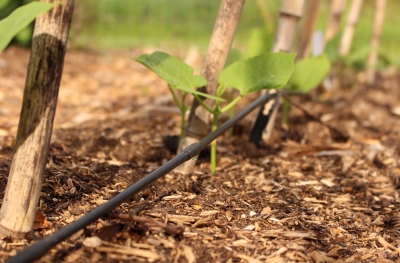
Not all my plants drink in the drips. Trees and shrubs are on their own except their first year in the ground when I religiously hand water them every few days initially, and then once a week throughout the season. These plants get 3/4 gallon per week for every square foot spread (estimated) of their root systems. That’s equivalent to an inch of rainfall which, if it does fall, exempts me from a few days of watering.
A couple of inches depth of hay, leaf, or wood chip mulch around the trees and shrubs seals in moisture to make best use of my efforts. Also, I start with smaller plants — less than 4 feet tall — which become independent of my watering sooner because a larger proportion of their roots are soon foraging around in surrounding soil that those of larger plants.
My flower beds also don’t get dripped. Although the soil surface is dry, moisture carried over from winter still sits in lower depths, into which established perennial flowers’ roots can tap. Annuals and newly planted perennials need to be watered on the same schedule as young trees until their roots reach that moisture.
It is my garden vegetables that drink in the benefits of my drip system. But even here some hand watering is needed these days. Down each bed runs 1 or 2 drip lines, with emitters along the lines spaced 6 inches apart. As water enters the soil, capillary pull from small spaces between the soil particles draws water sideways and, along with gravity, downward. The resulting wetting fronts have the shape, if you could look at a cross-section of the soil, of an ice cream cone. In clay soils, with small particles and, hence, a lot of capillary draw, that ice cream cone is very fat; in sandy soils, it’s narrow, a couple of feet wide at its broadest as compared with the 6 foot spread in a clay soil.
The wetting fronts start their sideways spread below the soil surface, deeper in sandy soils, more shallow in clay soils. In either case, the soil surface remains dry except right at the point of drip. So any vegetable transplants or seeds I set in the ground need to be hand watered until their roots reach the wetting front — except for seeds or transplants set right under or along the drip line.
Drip Irrigation Workshop June 20th; see “Workshops“, at this site, for more information.
A Statue of David
My friend David was wondering why the leaves of his Romaine lettuce plants flopped down. I gave my usual response to most gardening questions: “Too little water.” (My other usual response is “Too much water,” often following my first response if the questioner tells of watering all the time.)
So I asked David how much he watered, and he said he thoroughly soaked the ground by spraying it with water. Busted! It really was a water problem, too little in this case.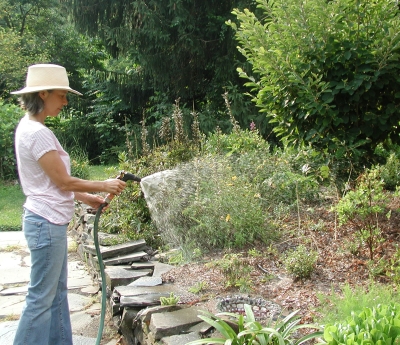
In fact, thoroughly wetting the soil with the usual 4-foot-diameter, hand held spray is almost impossible. “Thoroughly wet” means soaking the ground to at least a 6-inch depth. For his hand held sprayer to do that, David would have to stand in place like a statue, sprayer in hand, unmoving, for about an hour to wet one 4-foot-diameter part of the garden before moving on to the next 4-foot-diameter area.
When I’m watering plants in the ground by hand, I’m wetting only the small area beneath an individual plant, just enough to soak its roots as they establish themselves in the surrounding soil.
Probe the Soil
People find it hard to believe that that statuesque watering posture is really necessary. All you have to do is scratch the soil surface after a David-esque spraying of plants to see how deeply the water percolated, and you’d find only a thin layer of wet soil, at the surface.
Digging a hole in the ground is a good way to tell if watering was sufficient. But it’s also inconvenient.
For just a few dollars, I invested, years ago, in an electronic gizmo that bypasses all that hole digging. This soil moisture sensor has a metal probe that you plunge into the soil. Atop the probe is a dial or digital readout that tells whether the soil is “DRY,” “WET,” or something in between. More accurate sensors cost over a hundred dollars, but the cheap ones are fairly accurate and work well if coupled with observation.
Good for Pot(s) Also
The soil moisture meter is especially useful with potted plants, which might need watering every day when the weather is warm, sunny, and breezy. (With experience, lifting a pot to feel its weight is also a good measure of moisture level, as is just getting to know your plants better.)
I’m still hand watering the pots because I haven’t yet connected the drip tubes that will direct water to each of the pots.

